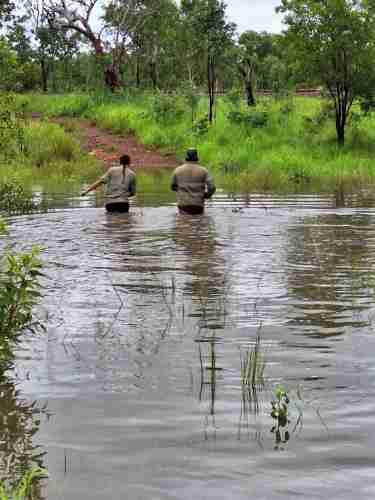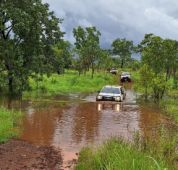

Never Walk Water Crocodiles !
Chances are you have been in this situation on more than one occasion. So you have a flooded section of road, what information does walking the flooded bit give us? It tells us how deep the water actually is (unless of course there is a flood marker which then gives us the depth at least) and also it gives us an idea of the condition of the track under the water. For example, is it sandy, muddy, seem firm, feel gravelly, does it have washed out sections, deep wheel ruts and or are there rocks or other obstacles under the water.
All of this is useful information for us to have before we drive into that space and will certainly be a major factor in determining whether we get through or not.
However, there are also limitations and potential safety concerns especially for us here in the north, and across the entire top end.
In the first instance, we may weigh 85 kg and as far as we can tell, the track seems “fine” but this can be a very different situation when we then drive our 4x4 dual cab through with a weight of up to 3000 kg. We may also not notice that there are deep wheel tracks on one or both sides which can cause or vehicle to “bottom out” and loose traction as soon as we drive into the water. We could also fall over, get tangled in submerged branches or fencing materials or cut our feet on sharp stuff.
Secondly, and this is actually a much greater issue, is that crocodiles can be found in those same creeks and flooded sections. So, walking through the water is not really an option in many cases. In fact, it could be a very dangerous thing to do depending on your location, obviously central Australia, coastal areas, a muddy puddle or proximity to creeks and rivers are all going to be very different. Hopefully this information forms part of your organisations vehicle operations policy or come along and do a course with us and we can also provide you with lots of additional information. Look at 4WD recovery course
Now there is another issue that we can raise here which is how deep is too deep and what can I actually take my vehicle through safely. This is a very complex question to answer as there are way too many variables. For example does your vehicle have a snorkel or where is your standard air intake located on your vehicle, tyre pressures and tread type is important, how much ground clearance does your vehicle have, is the water flowing or still, can you determine what the ground surface is under the water, what is your experience in these situations and what will you do if you get stuck or break down during the crossing? This is really something that we will need to address in another blog. Far too much information that needs to be covered to fit into this article.

So, to get back on track here, what about a flooded section on a stretch of bitumen highway, how do we approach that? Really its not that much different to any other flooded section of road in that, what does the marker say how deep the water is. All the other aspects also still apply re the ground surface, debris, washouts, croc’s, and whether its flowing and or simply flooded. We need to take great care in all these situations. Learn more about 4x4 training
Never just drive through without stopping to consider your next move, or at least slowing down considerably even if you can see its only 150mm deep on the marker. You can still loose control of your vehicle and end up in trouble. Spraying excessive water up into the engine bay when hitting it at speed can also be harmful to your engine and electronic components.
Having just observed another vehicle driving through before you get to the water crossing can be somewhat helpful in that you can use it to gauge your chances of getting through based on what vehicle they have, 4x4 or not, how far up on the car did the water come, flowing or a puddle, your vehicle weight (heavy or moderate/light, eg. cruiser vs double or single cab ute) and entry and exit points. Once again all of this must be considered before you attempt your crossing. Stay safe and think about your water crossings before attempting them. James Gorrie, 25 years experience driving throughout the NT.